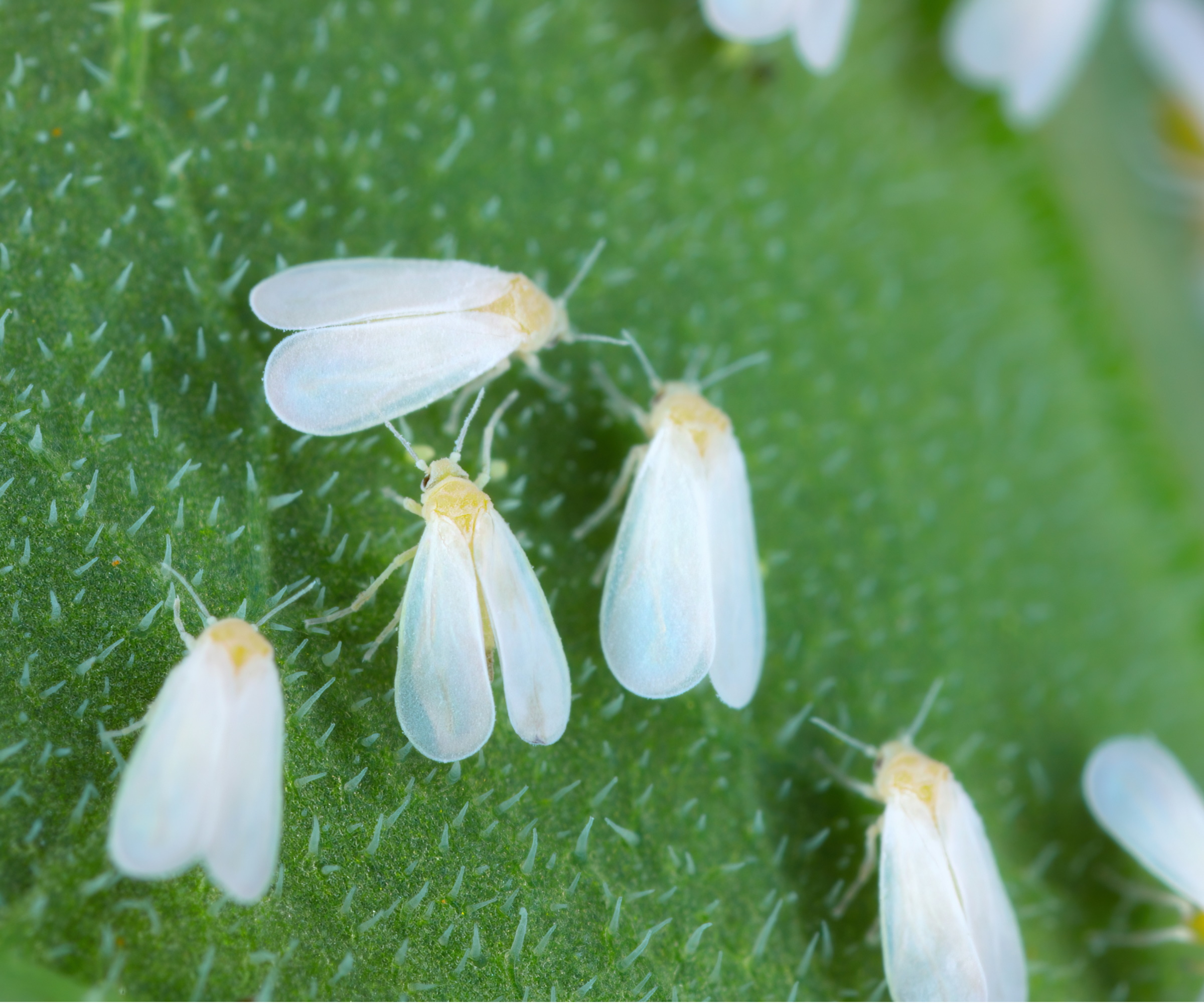How to get rid of whiteflies on houseplants – 5 steps to eradicate these pests for good
Once these pests take up residence among your houseplants, they can cause some serious damage


As a self-proclaimed houseplant lover, I've certainly had my fair share of pest problems and over time have figured out how to tackle them head-on. Whiteflies are one of those pests that leave you confused over how they came into your home in the first place because they're more commonly found among garden plants.
Those with a vegetable garden in their yard will likely have had to get rid of whiteflies at some point, with edible crops being a common target. However, they aren't fussy and will take up residence among ornamental plants, too. They often make their way indoors when you bring infested plants inside, or they enter through a window. Once they stumble across your houseplant collection, they can cause some significant damage. 'Whiteflies damage plants by piercing their leaves and stems and sucking sap from them. The leaves may turn yellow, wilt, or drop off prematurely. They may also develop discolored patches or appear dry, and the growth of the plant may become stunted or slow down,' says Mark Cleghorn, an entomologist from Arrow Exterminators.
A noticeable sign that you have a houseplant whitefly problem is discolored foliage that appears grainy and is infested with little white bugs. You can also spot the larvae as tiny white ovals on the underside of leaves. But don't worry, I've put together a simple step-by-step guide that will help you get rid of whiteflies on houseplants for good.

5 steps to get rid of whiteflies on houseplants
Like any common houseplant pest, it's best to tackle the problem as early as possible. Not doing so can result in dying plants and the problem getting out of control. Follow these simple steps to get rid of the whiteflies on your houseplants:
1. Isolate your infested houseplants

The first thing to do when you spot a pest on one of your indoor plants is isolate it - whether you're getting rid of spider mites on houseplants or getting rid of thrips, you need to put precautions in place to stop the pests from spreading.
In doing so, you should check if any plants surrounding your infected plant also have a pest problem. These should also be isolated to prevent further spreading.
Whiteflies multiply at a rapid rate, with the female laying eggs on the underside of leaves. Make sure to check the foliage of your houseplants to see if any larvae is lurking in a hidden spot. Due to their tiny size, you might find it useful to use this handheld magnifier from Walmart to inspect leaves.
Design expertise in your inbox – from inspiring decorating ideas and beautiful celebrity homes to practical gardening advice and shopping round-ups.
Try placing your affected houseplants in an open space, away from other indoor plants, like a conservatory.

Mark is a certified entomologist and Region Technical Training Manager at Arrow Exterminators.
2. Cut away infested leaves

With your affected plants at a safe distance from your other indoor plants, you can start tackling the whiteflies.
'To stop the spread of these flies, remove heavily infested leaves,' says Allan Bossel, pest control expert and Operations Expert at BBE Bed Bug Exterminator. Doing this makes it much easier to get rid of whiteflies for good. Look out for leaves that have particularly bad damage or lots of larvae on the underside of the leaves.
It can be disheartening to have to give your houseplant the chop, but the good news is houseplants will grow back. My Monstera deliciosa had to be ruthlessly cut back after a thrips infestation, but it quickly bounced back with multiple new leaves in just a few weeks - so, pruning away infested foliage can actually give your plants a boost of new growth.
When doing this, use essential pruning tools like these bypass pruning shears from Amazon. Make sure to clean your tools afterwards to prevent any potential spreads when you use your shears on another plant.

Allan Bossel currently serves as an Operations Expert at BBE Bed Bug Exterminator, where his extensive experience in bed bug and pest control allows him to maximize BBE’s service potential. Having founded his own pest control business in Michigan, Allan’s background is rich with over a decade of professional pest extermination and lab work experience.
3. Introduce nematodes

If you're like me and try to carry out eco-friendly garden ideas where you can, you'll be pleased to know there is a natural pest control method that can help get rid of whiteflies - nematodes.
Nematodes are microscopic organisms that are often used as biological control for a range of pests. They enter a pest's body and release a bacteria that kills it. Nematodes are safe for plants and pets, and won't leave any residue on your plants' foliage.
While you tend to apply nematodes to a plant's soil when dealing with something like a houseplant gnat infestation (because gnat larvae live beneath the soil), the approach is slightly different for whiteflies.
Whitefly larvae exist on foliage, so you need to mix this pack of beneficial nematodes from Amazon in some water and place it in a spray bottle (available at Walmart) to wet the leaves where the whiteflies are. You can likewise take a a soft, microfibre cloth and gently clean your houseplant leaves with the solution.
Always follow manufacturer instructions for the nematode product you are using.
4. Use a soap spray

If you're working with a bigger whitefly problem, you may need to take more drastic measures with bug sprays in order to save your houseplants. It's possible to use homemade bug sprays with soap to dehydrate and kill the whiteflies, for example.
You can also use a range of commercial products. 'A solution of neem oil with castile soap and warm water can be a good spray to combat whiteflies on your plants,' suggests Allan.
'Applying insecticidal soaps or neem oil sprays is also another option apart from this kind of biological control. These treatments do not adversely affect the environment the way certain commercial chemicals can, and they work by forming a layer on top of the whiteflies’ bodies, interfering with their breathing system,' he adds.
As Allan notes, these solutions will not impact the health of your houseplants and by using them indoors in a contained area, their impact on the wider environment is reduced.
Whether you use castile soap (available at Walmart), neem oil for plants (from Amazon) or an insecticidal soap (like this one from Amazon), the most effective method is to spray your affected plant's leaves directly. You will need to continue observing the leaves of your plants and repeatedly spray every few days until the whitefly population is gone. Once again, make sure to follow the manufacturer's instructions for the pest control products you use.
5. Set up sticky traps

To eradicate whiteflies from your houseplant collection entirely, it's important to also capture the adult pests flying around your plants. This is the same with getting rid of gnats, where your efforts to get rid of larvae will be outnumbered by the rate at which they reproduce.
'Adult whiteflies can be effectively caught by yellow sticky traps because they are attracted to the color yellow and get stuck on the traps, thereby reducing their numbers,' Allan explains.
Yellow sticky traps are widely available, like these yellow sticky traps from Amazon, and can be placed in the pot of your affected plants. It's important to note you may have to replace the sticky traps over time until the whitefly population is gone.
FAQs
How long does it take to get rid of whiteflies on houseplants?
The lifecycle of whiteflies depends on a few environmental factors, like temperature - it can be anywhere from three weeks to a few months long. On houseplants, it's important to be consistent with your pest control methods for several weeks to ensure you have got rid of them entirely. Keep monitoring your affected plants and continue pest control measures until there is no sign of a whitefly population.
What is the sticky substance from whiteflies?
Whiteflies are plant pests that leave behind a sticky substance known as honeydew. 'Honeydew can attract black sooty mold, which makes the plant look dirty. Additionally, honeydew can attract other insects, such as ants, posing another pest issue,' says Mark Cleghorn, an entomologist from Arrow Exterminators. You can easily remove honeydew by gently cleaning your houseplant leaves with a damp, soft cloth.
One of the biggest indoor plant mistakes is not dealing with a pest problem as soon as you spot it. A few things I do to keep pests at bay include regularly cleaning my houseplant leaves, ensuring they get airflow and isolating any new houseplants I bring into my home before adding them to my indoor plant display. If you notice other pests living on your houseplant soil, you might find our expert guide to getting rid of bugs from houseplant soil helpful.

Tenielle is a Gardens Content Editor at Homes & Gardens. She holds a qualification in MA Magazine Journalism and has over six years of journalistic experience. Before coming to Homes & Gardens, Tenielle was in the editorial department at the Royal Horticultural Society and worked on The Garden magazine. As our in-house houseplant expert, Tenielle writes on a range of solutions to houseplant problems, as well as other 'how to' guides, inspiring garden projects, and the latest gardening news. When she isn't writing, Tenielle can be found propagating her ever-growing collection of indoor plants, helping others overcome common houseplant pests and diseases, volunteering at a local gardening club, and attending gardening workshops, like a composting masterclass.